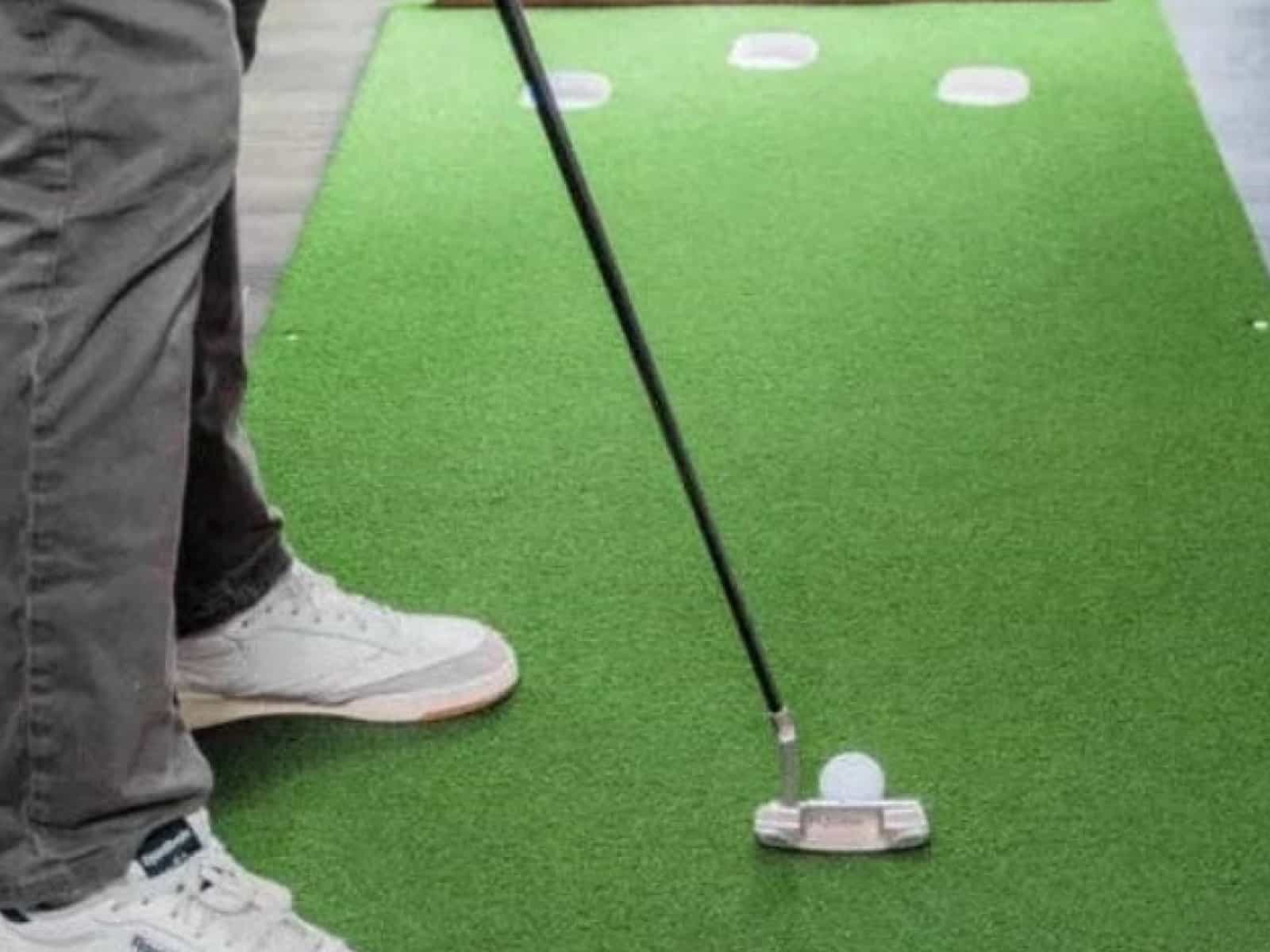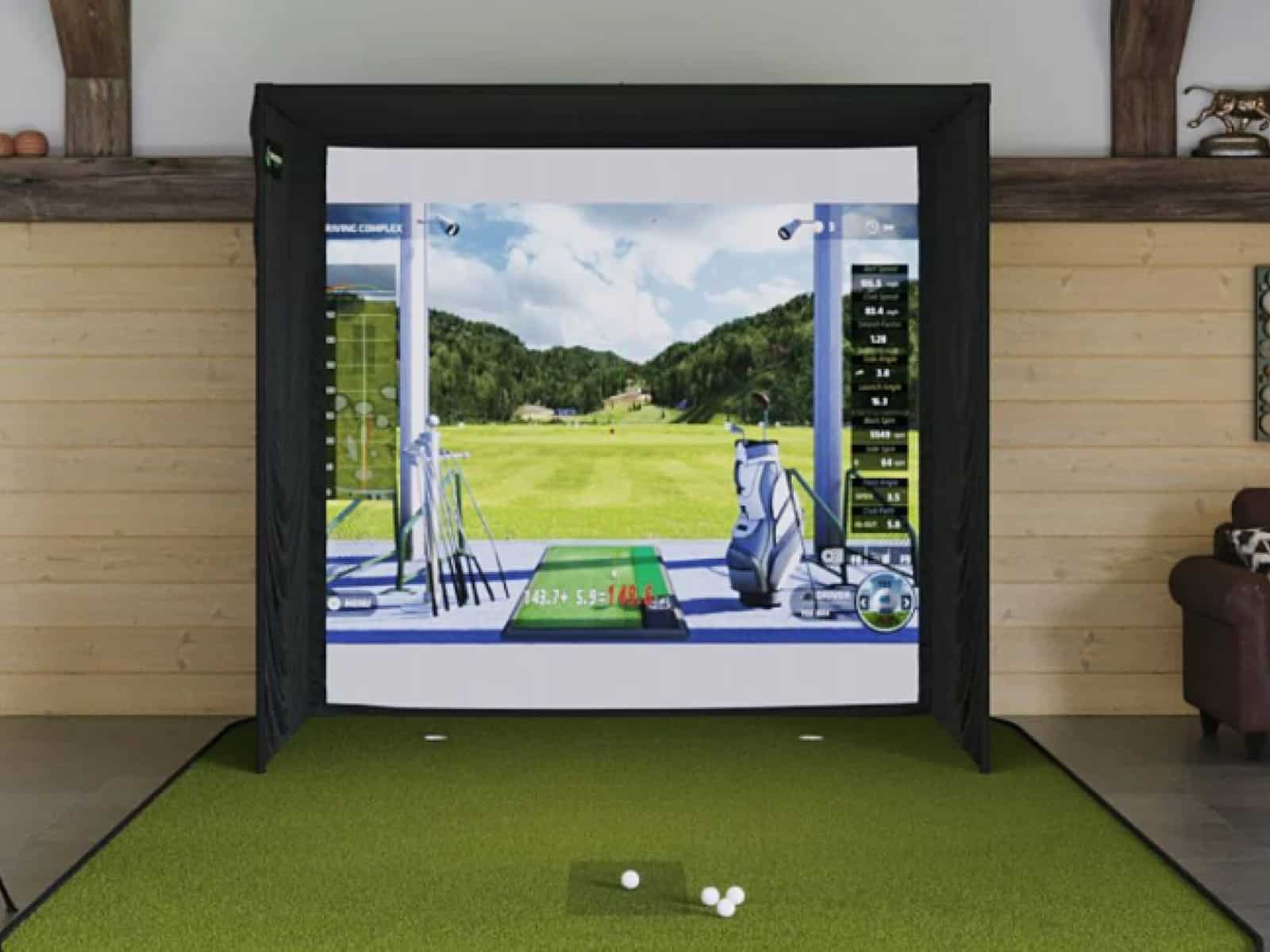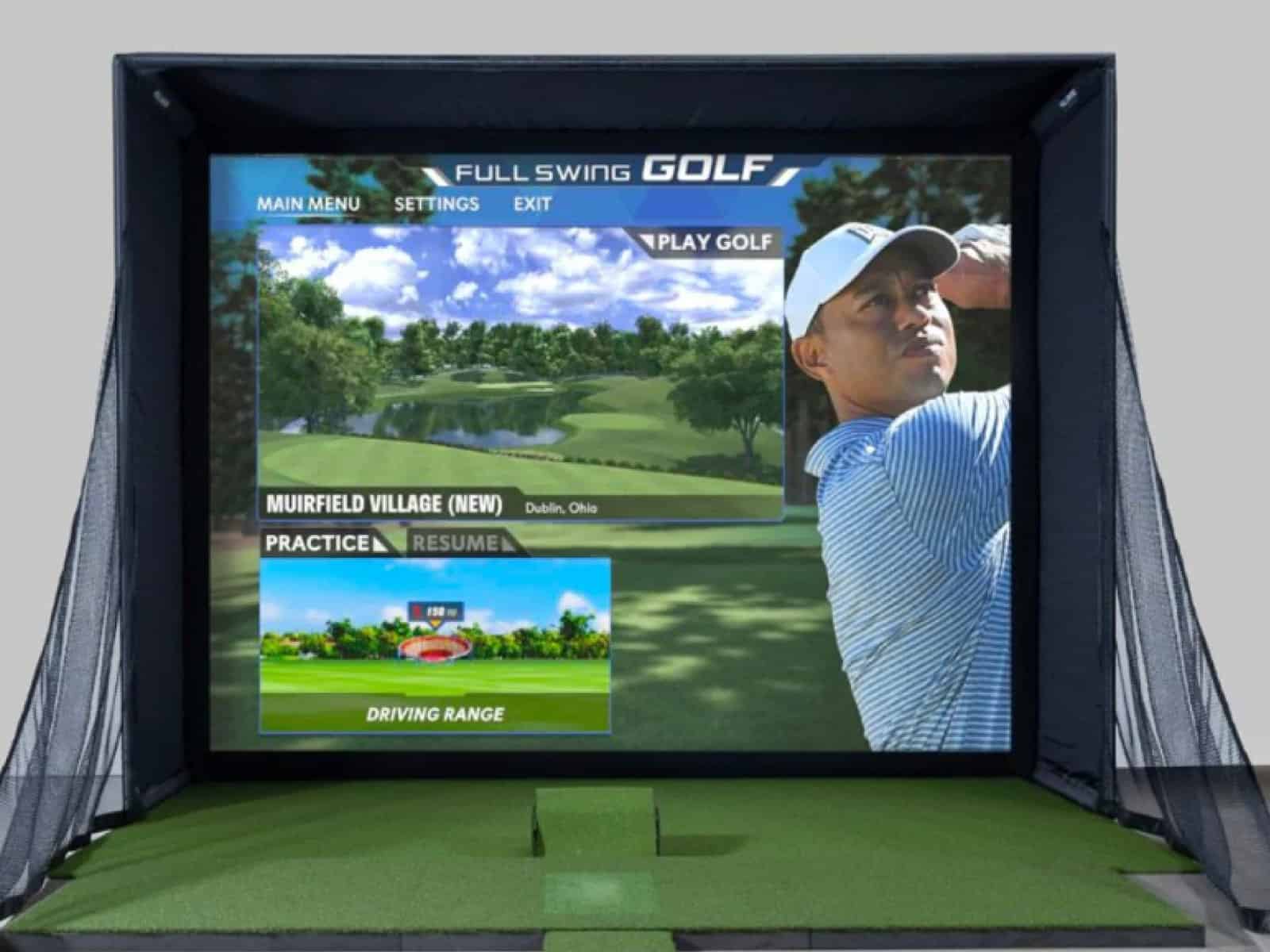Putting accounts for over 40 percent of strokes in an average round of golf. Executing good putts requires proper alignment, pace judgment, and excellent touch to get the ball rolling toward the hole. Whether practicing on real surfaces or simulator putting mats, the fundamentals remain the same – controlling face angle, swing path and impact point.
With technological advancements, modern sims are now capable (for the most part) of tracking putts and providing data to help you improve this crucial aspect of your game.
In this article, we will explore how putting works on a golf simulator, and how you can use those technological wonders to perfect your short game (putting and even pitching).
Different Putting Modes on Current Golf Simulators
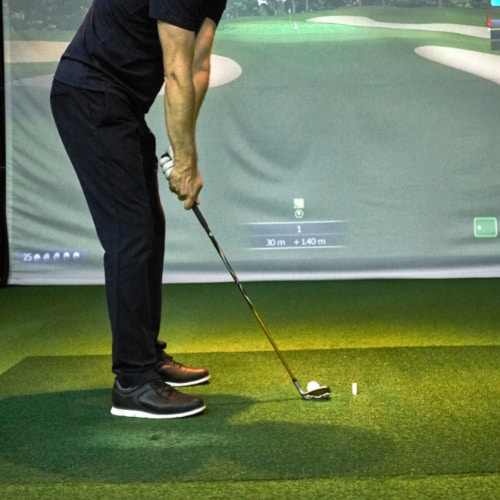
There are three different approaches to putting on a golf simulator, depending on your needs, limitations and preferences – Manual, automatic and gimme putts.
For manual putting, the sensors capture real-time metrics as you stroke putts with your own putter just as on a real putting green. Sensors record metrics like face angle, swing path, impact spot, and speed to simulate putts rolling on virtual greens. This allows for meticulously working on stroke mechanics. This is the way to go if you want to work on your putting skills.
Auto-putt modes skip the manual swing, instead automatically sinking putts within an adjustable proximity to the hole depending on the chosen difficulty. This expedites pacing when playing full 18-hole rounds. Players specify the maximum distance range for auto-sunk putts.
Lastly, some simulators offer gimme putts – allowing you to pick up and tally very close putts without stroking them. This keeps casual rounds or contests moving briskly. You can adjust the gimme radius from as little as 12 inches out to over 5 feet depending on time constraints.
How Manual Putting Works on a Golf Simulator
Golf simulator software uses advanced sensors and algorithms to track putting strokes and provide detailed statistical feedback. However, executing realistic putts on artificial surfaces still poses many challenges.
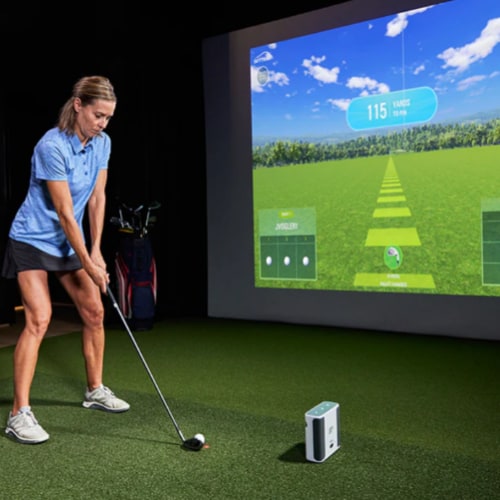
Putting Analysis Technology
Specialized sensors in golf simulators can measure key aspects of the putting stroke. These include:
- Face angle at impact
- Swing path direction
- Point of impact on the putter face
- Takeaway time
- Follow through time
- Tempo
Some systems (such as Flightscope’s X3) also estimate factors like distance to pin, launch speed, skid distance, roll distance, total distance, etc. to further replicate real putts.
Interpreting & Displaying Putting Data
The simulator computes the sensor readings into overall statistics like putting distance, direction, ideal path rendering, face angle degree, etc. It generates graphics overlaying the video replay of the stroke. This allows for visually pinpointing any existing flaws.
The software tallies long-term stats to monitor consistency and progress over multiple sessions.
Factors Affecting Putting Accuracy
While sensor precision keeps improving, some variables are still difficult to simulate compared to real greens, including friction and ball roll physics, surface vibration and sound, green contours and multiple break lines, changing grass textures, etc.
However, convenience and consistency make simulators useful practice tools before facing actual course conditions.
Strategies for Improving Your Putting
Golf simulators offer useful data and training tools to develop repeatable, reliable putting strokes. Applying that information correctly is key to skill building.

Using Putting Data Over Time
Analyze your simulator statistics over successive practice sessions to spot trends. Look for patterns in the numbers and graphics that indicate strengths to reinforce and weaknesses to correct.
Specifically, identify your common missed directions based on statistics like face angle and swing path at impact. See if you consistently push putts right or pull them left of the target. Also, look for trends related to putts falling short or going too long.
In addition, set specific benchmarks for improvement percentage goals over a period of weeks. For example, you might aim to increase putts made from 5 feet by 15% over the next month. Comparing practice putting rounds before and after making technique changes will show consistent positive gains if an adjustment is effective.
Training Aids & Instruction
Many golf simulator systems have built-in training aids and games to develop putting skills. Strobe lighting, guidelines and target challenges force you to perform putts under variable conditions.
Strobe tools encourage proper tempo training by breaking down the putting motion (takeaway, impact and followthrough). As the strobe frequency decreases, you must smooth out your overall rhythm.
Visual path guides model the ideal swing plane and extended ball roll line for various putt trajectories. Repeating strokes along the optimal path ingrains muscle memory for consistency.
Target placement challenges on the simulator screen let you rehearse tricky short, downhill and long uphill putts by testing proper pace and line.
For maximal improvement, take remote putting lessons from certified coaches. Their expertise in decoding simulator stroke data and graphics will perfect your fundamentals for real-world success on the greens.
Equipment & Setup Considerations
Fine-tune equipment specifications and posture elements to maximize your putting practice on the simulator:
Carefully fit the proper putter lie angle, length, loft, and grip style for your build and stroke technique. Stance width, ball position and eye alignment line should also align to enhance your motion.
Getting custom fit for putters and perfecting posture variables pays off by optimizing gear performance. This allows easily repeating your ideal swing under the simulator’s unique practice conditions.
For those golf enthusiasts committed to refining their putting technique, choosing the right equipment is crucial. That’s why searching for the best putting simulators becomes imperative. These systems not only offer a realistic golfing experience but can also be tailored to suit your individual playing style, providing a comprehensive solution for those looking to advance their skills on the green.
The Future of Simulator Putting
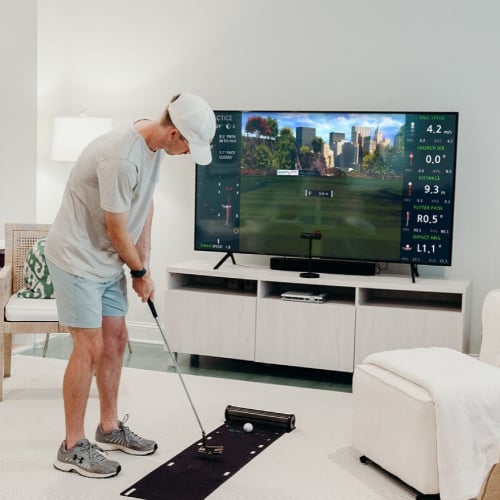
While the current golf simulator putting capability is impressive, developers aim to enhance the realism even further with tech upgrades in the coming years.
Expectations for More Realistic Experiences
As simulator sensors and graphics constantly evolve, golfers expect steady improvements in multiple areas to make the practice experience indistinguishable from real greens.
On the hardware side, higher resolution cameras paired with ultra-high-definition software promise more responsive, smoother visuals for accurately rendering ball roll and final stopping points.
In terms of metrics, more sensitive electronic putter face plates and ball impact sensors will precisely capture nuances like face rotation, launch angle variations, and exact skid/forward roll cycles.
Adaptable putting mat materials should better mimic the fast/slow, bumpy/grainy conditions of real course turf textures and contours.
Together, these tech enhancements aim for near-perfect measurement and authentic visual response to ultimately feel like holing out on the worlds best greens.
Potential New Features & Capabilities
Developers are expanding simulator connectivity to other golf tools which may unlock exciting new capabilities:
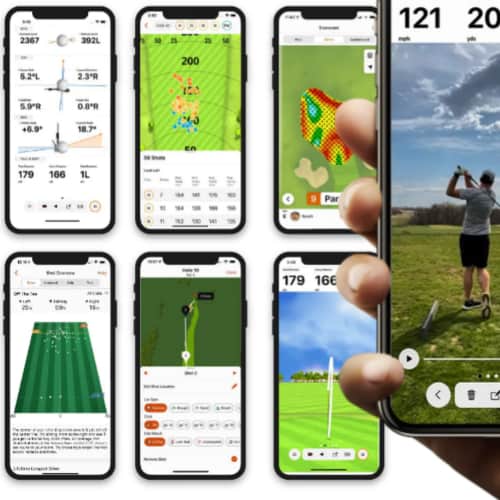
Via integration with green contour reading apps, the simulator could display precise putt break lines based on exact hole location. This takes practice green speed judgment to new levels.
Using wireless networking with premium launch monitors, golfers can seamlessly view club delivery metrics on simulator video replay without any disruptive setup.
For consolidation across practice mediums, simulator and on-course putting statistics could be tracked together on shared online dashboards. This enables unified analysis.
Finally, multiplayer training games, contests and global leaderboards would add skills challenges and community aspects for extra motivation during solo practice sessions.
Broader Availability & Adoption
Combined hardware improvements and innovative crossover features will likely accelerate mainstream adoption well beyond early enthusiast channels as costs drop:
Expect viable sub-$1000 consumer simulator packages allowing golfers to practice putts from home before heading to the course. One excellent putting-only system is the Exputt EX500D Real-Time Putting Simulator. Highly compact office/clubhouse rigs will also enable convenient practice close to the links.
Rapid expansion of deluxe indoor simulator golf venues now makes daily use practical too through pay-per-hour access. Most exciting is how broader accessibility and distribution can make high-tech simulator practice a routine step in every golfer’s skill development regardless of climate, budget or location constraints.
Frequently Asked Questions
Let’s now answer some of the most widely asked questions related to putting on golf simulators to help you better understand the benefits of technology in improving your golf short game skills indoors.
How accurate are simulator putts compared to real greens?
While factors like subtle terrain variations are still difficult to simulate, modern sensors precisely measure face angle, path, pace, and more to render realistic ball rolls. Constant hardware and software improvements aim to close any remaining “realism gaps”.
Can simulator putting practice develop bad habits?
Not if you make use of proper coaching and instructional feedback tools built into leading systems. Proper fundamentals get ingrained since ideal stroke graphics overlay your real results. Gear fitting also optimizes equipment for your build and motion.
Are golf simulator putting surfaces drastically different from real greens?
Simulator putting surfaces continue getting more realistic. Surface firmness can be adjusted on some units via interchangeable turf mats. Most visual aspects like ball dimple impressions are simulated. The biggest remaining challenges mainly involve matching subtle speed variances of actual grass.
How can I maximize training value from a putting simulator session?
To maximize your virtual putting practice sessions, you can use the following:
– Built-in games/challenges putting to virtual hole locations.
– Vary distance/slope.
– Pay special attention to stats tracking to monitor consistency from session to session.
– Book remote putting lessons on the simulator with a coach to optimize integrating data for perfecting real weaknesses.
What are the biggest future improvements expected in simulator putting?
Even more precise sensors and detailed graphics, plus creative features like integration with green-reading apps, launch monitors and multiplayer contests that make practice more entertaining. Also, expect broader access via lower-cost home options and additional public simulator golf venues focused specifically on the short game.
Moreover, you can expect better putting systems with the integration of more advanced technologies like Virtual Reality and Augmented Reality. These can take golf simulation to another new level once widely integrated into simulation systems.
Conclusion
Golf simulators have become extremely useful for developing sound putting technique regardless of outdoor practice limitations. These systems accurately measure and display key stroke metrics to understand proper impact factors.
Practicing putts on high-quality golf simulators is an excellent way for all skill levels to reinforce solid stroke fundamentals, address trouble spots and build confidence before teeing off. A few sessions per week can quickly improve touch, distance control and reading abilities leading to more one putts, and things will only get better and better with technological advances.
If you still have comments or questions, make sure you contact us by email or in the comments section below.

